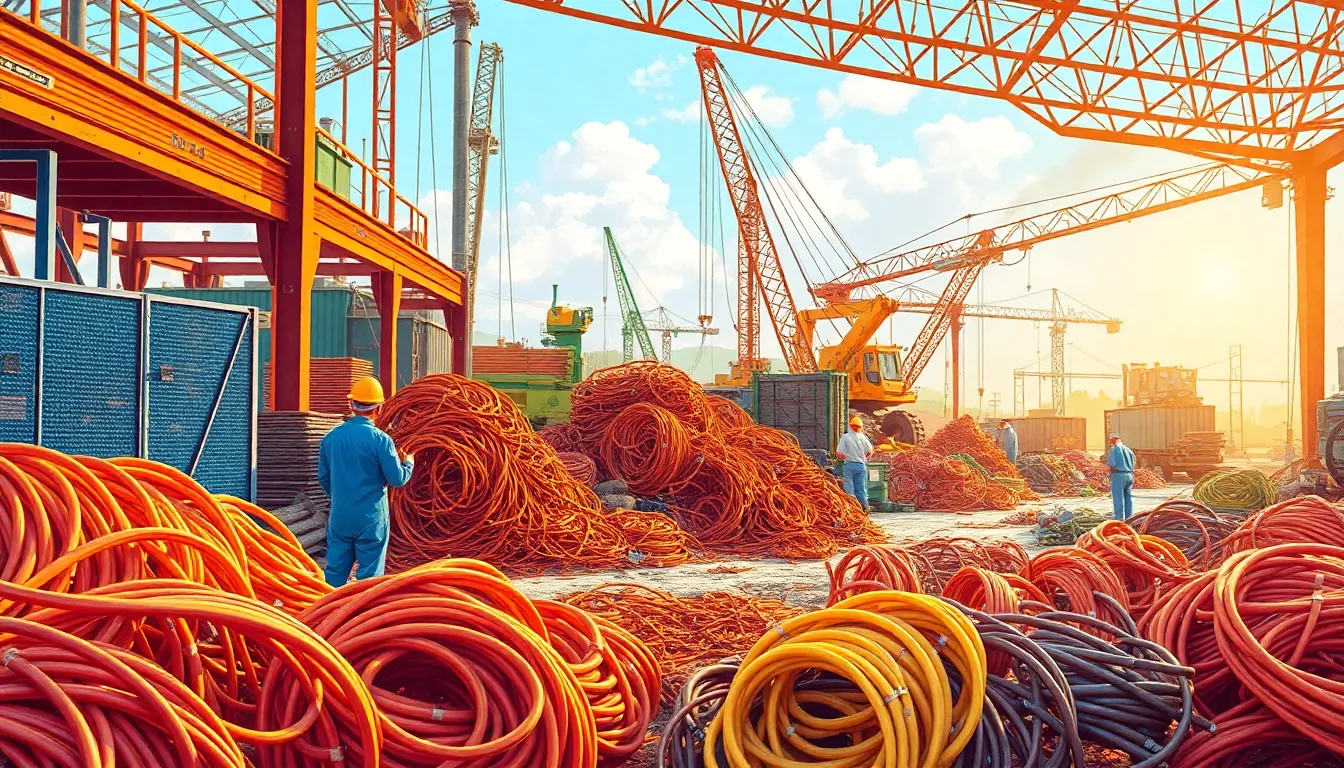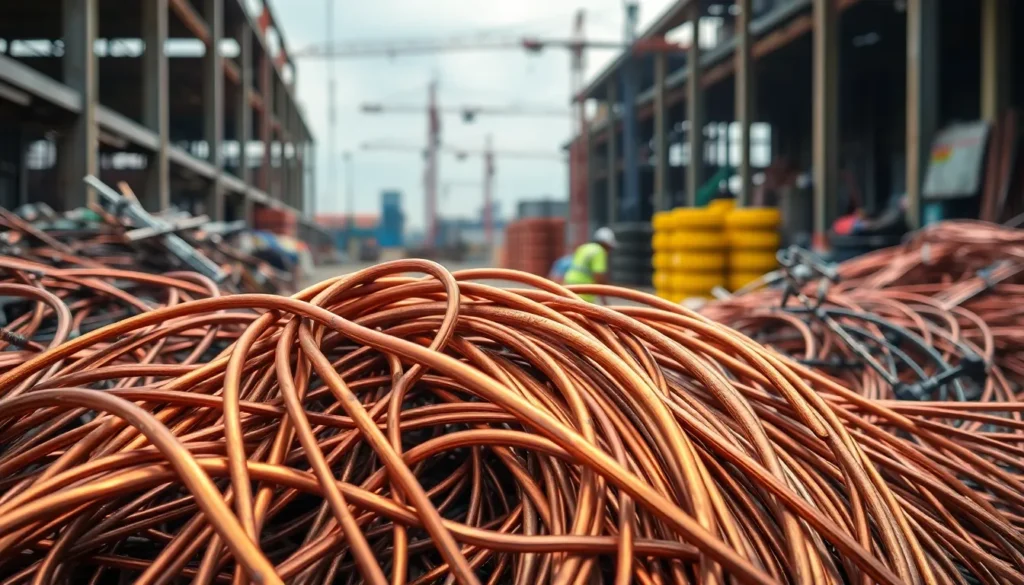In a world where prices can swing like a pendulum on a caffeine high, scrap copper is no exception. Investors and recyclers alike keep a keen eye on this shiny metal, hoping to strike gold—or at least some green—when the time is right. With the demand for copper soaring and supply chain hiccups causing ripples, the future of scrap copper prices is a hot topic that can make or break budgets.
But what’s the crystal ball saying? Will copper prices soar to the heavens or crash like a bad reality TV show? This article dives into the predictions and trends shaping the market, offering insights that could turn even the most skeptical into copper enthusiasts. Buckle up as we explore the twists and turns of scrap copper pricing—who knew metal could be this exciting?
Table of Contents
ToggleFuture Scrap Copper Price Predictions
Scrap copper prices reflect several dynamic factors. Supply chain issues, particularly stemming from geopolitical tensions and trade policies, influence market fluctuations. Forecasts predict an upward trend in prices due to increasing demand from sectors like construction and renewable energy. Analysts anticipate that electric vehicle production will drive further consumption of copper.
Historical price trends indicate significant responsiveness to global economic conditions. For instance, if economies recover post-pandemic, heightened industrial activity could boost prices. Additionally, the transition to green technologies entails increased copper usage, elevating market interest among investors.
Recent data suggests that prices might hover between $3.50 and $4.00 per pound in the next 12 months. Market experts highlight the importance of monitoring Federal Reserve policies, which affect overall inflation rates. Economic indicators, including manufacturing output and employment rates, will also play crucial roles in shaping prices.
Diversified predictions reflect a mix of cautious optimism and potential downturns. The environmental regulations on mining practices may escalate prices further, as they create tighter supply constraints. As electric grid improvements and renewable energy initiatives expand, demand for scrap copper is poised to rise.
Regularly updated statistics and insights can provide a clearer picture of future trends. Maintaining focus on global events will be fundamental for investors and recyclers looking to navigate the volatile landscape. Engaging in market analysis regularly allows stakeholders to make informed decisions in this unpredictable environment.
Factors Influencing Scrap Copper Prices

Scrap copper prices fluctuate due to several key factors that shape the market landscape.
Economic Trends
Global economic trends significantly impact scrap copper prices. Economic growth stimulates demand across multiple sectors, especially construction and manufacturing. Analysts note that periods of expansion often correlate with rising copper prices, while recessions tend to lower demand. Inflation rates influence purchasing power; higher rates can decrease consumer spending and dampen industrial activity. Central bank policies also play a crucial role; changes in interest rates influence market liquidity. Economic indicators, like GDP growth and manufacturing indices, provide valuable predictions of future price movements.
Supply and Demand Dynamics
Supply and demand dynamics remain central to scrap copper pricing. It experiences upward pressure during times of strong demand from industries like renewable energy and electric vehicle production. Scrap copper supply is affected by recycling rates and mining outputs. When recycling efforts increase, supply strengthens, helping stabilize prices. Geopolitical events can disrupt mining operations, tightening supplies and escalating prices. Seasonal factors also contribute; demand often spikes during warmer months due to construction activities. Monitoring these dynamics offers essential insights into potential price trends.
Historical Price Trends
Historical trends in scrap copper prices demonstrate significant volatility, reflecting various economic factors over time. Prices have often reacted to global market demands, economic growth, and geopolitical events.
Analysis of Previous Price Fluctuations
Previous fluctuations showcase how scrap copper prices peaked near $4.50 per pound in 2021 before experiencing a decline. During the last decade, key events such as the COVID-19 pandemic and supply chain disruptions caused notable shifts. Investors observed that demand surge during recovery periods led to price rebounds, while economic slowdowns resulted in price drops. Prospective buyers and sellers can note that prices often reflect broader economic conditions, confirming the interconnectedness of copper with industries such as construction and manufacturing.
Lessons Learned from Past Predictions
Past predictions offer valuable insights into market behavior. Analysts noted that reliance on historical data often led to accurate predictions, especially during times of consistent demand. Significant price changes occurred when markets faced unexpected shocks, highlighting the need for adaptability. Observations reveal that monitoring global trends and economic indicators remains essential for making informed decisions. Connecting these lessons to future predictions can enhance understanding and preparedness for potential price changes in the scrap copper market.
Expert Opinions and Forecasts
Expert analysis provides valuable insights into future scrap copper pricing trends. The landscape is shaped by a complex mix of economic variables.
Insights from Industry Analysts
Industry analysts project a cautious optimism regarding copper prices. Increased infrastructure spending is expected to drive demand across numerous sectors, particularly construction and renewable energy. Market experts observe that evolving technologies in electric vehicles could further enhance consumption. Analysts stress close monitoring of global supply chains, as disruptions could affect availability. The anticipated price range for scrap copper during the upcoming year stands between $3.50 and $4.00 per pound. Key indicators, such as global economic health, play a crucial role in these forecasts, suggesting a responsive market landscape.
Predictions from Financial Institutions
Financial institutions express a favorable outlook for scrap copper prices. Research teams emphasize the growing demand for copper as essential for green technologies and electric vehicles. Price forecasts suggest that financial dynamics, such as inflation and interest rates, will influence market movements. A combination of cautious spending patterns and robust economic recovery could push prices upward. Institutions project prices could trend higher, aiming for an average of $4.00 per pound within the next twelve months. Experts from these institutions encourage stakeholders to stay informed on geopolitical developments, as these factors could significantly alter market conditions.
Market Implications of Price Changes
Scrap copper price changes hold significant implications for various market players, including dealers and manufacturers.
Impact on Scrap Metal Dealers
Scrap metal dealers face direct consequences from price fluctuations. Increased prices often lead to higher margins, enticing more individuals to sell scrap copper. Conversely, when prices drop, profit margins narrow, potentially reducing dealer revenues. Some dealers may struggle to maintain inventory levels if prices remain unstable. Awareness of market trends allows dealers to make strategic decisions about purchasing and selling. Dealing with rising prices encourages tighter competition among dealers, which can benefit consumers through better prices.
Effects on Manufacturing Industries
Manufacturing industries experience a ripple effect from changes in scrap copper prices. Higher copper prices increase production costs, which manufacturers might pass on to consumers. Industries reliant on copper, including construction and electronics, face pressure to control expenses. It becomes essential for manufacturers to explore alternative materials or improve recycling strategies to mitigate rising costs. Expansion in renewable energy and electric vehicle production sets a growing demand for copper. Consequently, manufacturers must adapt to these trends to remain competitive and responsive to market shifts.
The future of scrap copper pricing holds both promise and challenges. With rising demand from key industries and the influence of global economic factors, prices are likely to see upward momentum. However potential disruptions from geopolitical events and supply chain issues remind stakeholders to remain vigilant.
As the market evolves, staying informed about economic indicators and industry trends will be crucial. This awareness enables scrap metal dealers and manufacturers to make informed decisions and adapt strategies effectively. The outlook for scrap copper remains optimistic, but navigating this dynamic landscape requires continuous analysis and adaptability.

